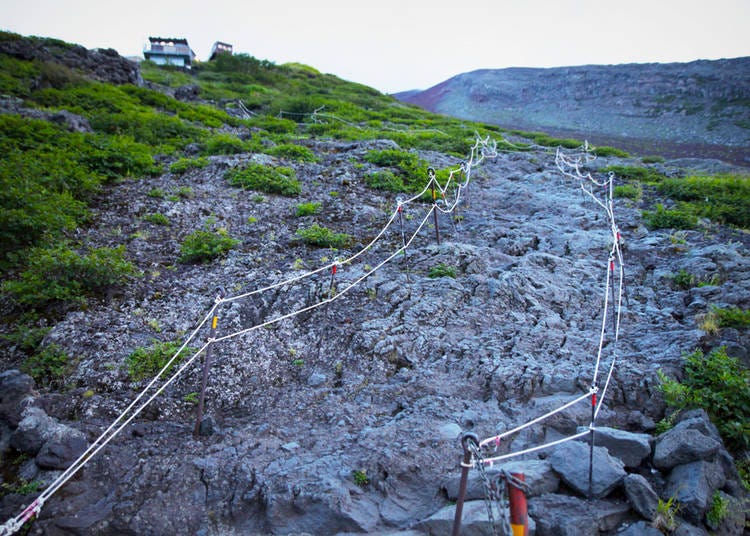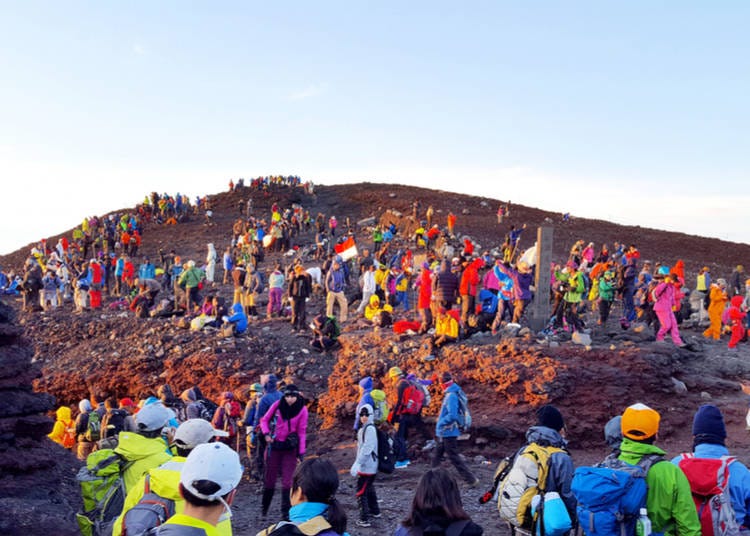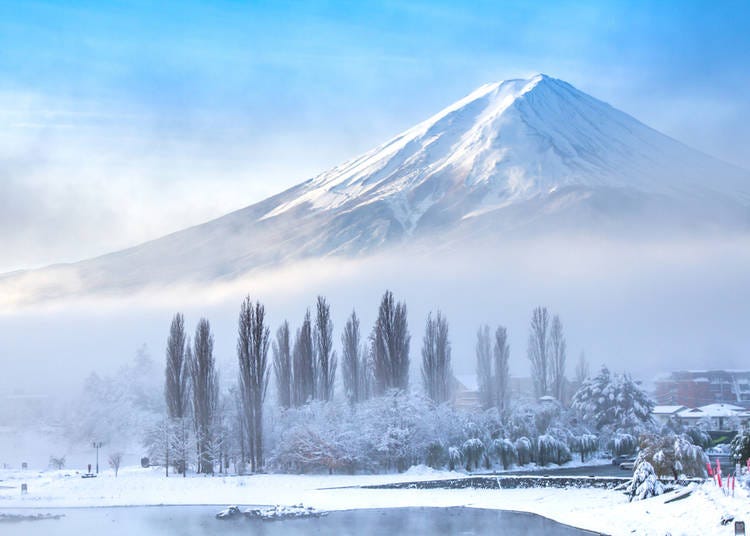
Complete Mount Fuji Travel Guide: Access, Hiking Trail Tips & More!
- Written by: Lucio Maurizi
Among the many attractions visitors in Japan long to enjoy, Mount Fuji (or Fujisan as Japanese people call it) is one of the most sought-after ones – either as a hiking destination or a selfie spot.
Standing at 3776 meters above sea level, Mount Fuji is the tallest mountain in the country. Its iconic image and beauty, every year, compels huge crowds of tourists from Japan and abroad alike to look for the best location to admire its shape and snap photos.
Here in this complete guide we will introduce the area right around Mount Fuji, how to get to Mount Fuji from Tokyo, and other essential information on climbing Japan’s most famous mountain.
Where to see Mount Fuji: The Kawaguchiko Area

Several areas around Mount Fuji are amazing to enjoy the view but the most warmly recommended one would be the area around Lake Kawaguchi (Kawaguchiko in Japanese). Sitting just north of Mount Fuji, this area will offer one of the best angles for postcard-worthy pictures, but also much more. The area takes the name from its lake, the second largest of the five lakes resting around Mount Fuji. It’s a popular resort with many lake-side hotels, windsurfing facilities, camp sites, fishing spots and excursion boats.
Kawaguchiko is also home to Ooishikoen Park, a large natural park, famous for its colors, but especially interesting between mid June and the beginning of July. During these weeks a popular “herbs festival” takes place, while in December the park sets up mesmerizing light shows.
What makes this park very sought after among Japanese visitors is that it’s renowned to offer, on a clear day, the view of the so-called “double Fuji”. The visage of the mountain reflects into the lake creating a clear mirror image. Furthermore there are many beautiful hotels, the nearby theme park Fuji-Q Highland, as well as museums and entertainment of many kinds.
How to get to Mount Fuji - Kawaguchiko from Tokyo

Take the JR Chuo Line from Tokyo's Shinjuku Station to Otsuki Station (70 minutes, about ¥2500 by direct limited express train or 100 minutes, ¥1320 by local trains with usually one transfer along the way). From Otsuki, take the Fujikyu Railway Line to Kawaguchiko Station (55 minutes, ¥1140 one way).
The JR Tokyo Wide Pass covers the entire journey (except panorama seats on limited express trains); however, the Japan Rail Pass and other JR passes are not valid between Otsuki and Kawaguchiko.
By Bus
■ From Shinjuku Station
Access: Take the Fujikyu or Keio Bus from the Shinjuku Bus Terminal in Tokyo (to Kawaguchiko Station)
Cost: ¥1750 (one way)
Time: Approximately 2 hours.
Note: The Japan Rail Pass is not valid on these buses.
■ From Tokyo Station
Access: Take the Fujikyu or the JR Kanto Bus From Tokyo Station (Yaesu South Exit) to Kawaguchiko Station.
Cost: ¥1800
Time: Approximately 2 hours
Note: Online reservations can be made through Willer, Japan Bus Online and kosokubus.com.
The Japan Rail Pass is not valid on these buses.
■ From Shibuya Station
Access: Shibuya (Mark City)
Cost: ¥1800
Time: Approximately 2 hours.
Note: The Japan Rail Pass is not valid on these buses.
■ From Narita Airport
Access: Take the Keisei Bus #7 from Terminal 1, or Terminal 3; #11 from Terminal 2.
Cost: 4,400 yen (one way).
Time: Approximately 4 hours
There are also several other busses leaving from many areas of Tokyo. The options above should be able to accommodate all visitors, but should you need alternatives, please refer to:
https://highway-buses.jp/
http://bus-en.fujikyu.co.jp/highway/detail/id/1
Seeing Mount Fuji: Loop Buses around Lake Kawaguchi

Climbing Mount Fuji can certainly be a great experience, but what if you can’t or don’t want to, yet you still would like to enjoy some amazing sights without having to spend days in the area?
Several companies have set up the so-called loop bus tours. As the name suggests these are rides circling around Mount Fuji, passing by landmarks and points of interest such as Lake Kawaguchi, the Churehito Pagoda, the Oshino Ninja Village, the Sengen Jinja shrine and much more. Depending on the company, there are several tours a day (at least 6, in summer, but less in winter).
Access: From Kawaguchiko Station bus terminal
Cost: 1500 yen per person
Time: The tour lasts approximately 70 minutes
Climbing Mount Fuji: About The Fuji 5th station and the main trail

Those who seek to hike Mount Fuji can choose to do so from its base, but most people, in order to make it a 1-day hike, start from the so called Gogoume - the 5th of several stations, which marks the half point of the trails leading to the top of Mt. Fuji. From this station you can take several trails. Depending on which one you choose, and on your own pace, the hike could take anywhere between 4 and 8 hours.
Yoshida Trail
At a glance:
-Climb time (Approx.): 5 hours 40 min
-Descent time (Approx.): 2 hours 20 min
The Yoshida route will be the easiest to approach for beginners. The Yoshida route starts you off at the 2,305 meters mark. At this route’s 5th station there are shops, and more inns than there are along other paths. More importantly the route is equipped with 3 rescue stations, against only one in the Fujinomiya trail, and none in the others.
Regardless of which route you choose, the 5th station presents hotels, stores, and restaurants to prepare for your hike. In addition you’ll be able to buy souvenirs - although we would recommend to do so after your descent. The website and the local signs suggest to start climbing in the late evening to ensure that you reach the summit and enjoy the sunrise from the top of the mountain.
How to Climb Mount Fuji: The other hiking paths

Subashiri Trail
At a glance:
-Climb time (Approx.): 5 hours 10 min
-Descent time (Approx.): 2 hours 40 min
The Subashiri trail (starting around 1970 meters above sea level) is less crowded. Starting on the east side of the mountain it allows for a quieter, albeit it more challenging ascent, especially if you choose to hike at night. The Subashiri trail leads you through a forest path, which is made harder to traverse by frequent fog and all around limited visibility. If you choose this path please be mindful of these factors and make sure to be equipped with a headlight. Like on the Yoshida trail, you’ll be able to see a clear sunrise (assuming the weather is nice) once you reach areas above the 5th station. Starting at the main 8th station (Mount Fuji presents several stations numbered the same way), the Subashiri and the Yoshida trails merge into one. This trail is particularly scenic in the composed by volcanic rocks and gravel. Note however that Subashiri has no rescue stations.
Fujinomiya Trail
At a glance:
-Climb time (Approx.): 5 hours
-Descent time (Approx.): 2 hours 40 min
The Fujinomiya trail (2380 meters above sea level) is the shortest path, but it can also be more dangerous that the previously mentioned ones. In fact it presents steep slopes and loose terrain. Unlike the other 3 trails, Fujinomiya’s ascent and descent routes are the same. For this reason is less likely to get lost on this path, but you should pay attention to situations when hikers climbing up and down at the same time cross paths, as potential incidents are more likely to happen. The only rescue station on this trail is at the 8th station. Both Subashiri and Fujinomiya have inns at every station.
Gotemba Trail
At a glance:
-Climb time (Approx.): 6 hours 50 min
-Descent time (Approx.): 3 hours 5 min
The Gotemba trail is the hardest of the paths you can choose. It’s a 10.5 km hike with no rescue stations, and no bathrooms or rest stops until the 7th station. The path is also marked by less signs than there are on the other roads.
Expert hikers might want to choose this path because one can see the sunrise from anywhere on the path. Furthermore, because of its complexity it’s the least walked path, offering the quietest climb to the top. Gotemba, like Subashiri, runs through volcanic terrain, making the view both mesmerizing and humbling for any visitor. Those who choose to hike to the top via Gotemba should make sure to be well equipped and to carry enough food and water to last for a long hike.
Fuji FAQ: When is the best season to climb Mount Fuji? About the climbing season

The climbing season is between July 1st and Mid September, although there are some differences depending on the route. The Yoshida trail is accessible from July 1st to September 10th, but the other routes, while closing on the same date, open on July 10th. Yoshida also extends the climbing season by one day for those who choose to only do the descent from the 5th station.
The Fujinomiya trail opens on the 8th of June only between the 5th and the 6th stations. It’s important to note that these dates may change depending on weather conditions.
Points to note before climbing Mount Fuji

1. Climbing Mount Fuji has become an extremely popular activity
Reaching the summit of Mount Fuji has been a popular staple of Japanese tradition for a long time, but in recent events the appeal for this activity has increased exponentially among visitors from all over the country and the world. From the city of Tokyo, it takes about 5 hours to reach the 5th station. The time it takes to reach Mount Fuji though is only one of the things one must consider when preparing for the trip.
2. Bring loose change for bathrooms
Mount Fuji is not only a World Heritage Site, but it’s one of the three holy mountains of Japan. Alongside Mount Haku and Mount Tate, Mount Fuji is, in fact sacred ground. For this reason, it’s important to remember that it is forbidden to relieve oneself on the mountain itself. Due to the very large number of visitors, access to bathrooms may be a problem. You should expect very long lines (up to 1 hour wait or more). Furthermore make sure you bring a few ¥100 coins with you. In order to access the toilets you’ll have to pay ¥100-300.
3. Plan on staying on the mountain? Book well ahead
Depending on the trail you choose you may encounter more or less inns (or huts). Should you choose to stay at an inn, make sure to book well in advance. Furthermore please take into consideration that inns on Mount Fuji, are designed more like rest stops than regular hotels. You should be aware that many will not have shower rooms, running water, or baths. Additionally, some may only have mixed rooms for both men and women.
That being said, some may have dedicated Wi-Fi, single rooms and private spaces, but they will be harder to find and will require booking even more time in advance. On weekends, prices might increase.
More commonly people use the cheaper and more accessible “mountain huts”. For these accommodations you’ll be able to only book via phone and they may not accept credit cards, so make sure to have enough cash on you.
4. Take climbing seriously
As popular as Mount Fuji climbing is, please remember that it’s a true mountain climb and should not be taken lightly. It’s recommended not only to have good equipment, but also to prepare in advance in terms of training.
While you’ll be able to buy water and food along the trails, it’s important to bring some of your own with you.
Even in summer, temperatures on the summit of Mount Fuji fall below freezing. Make sure you bring warm clothing.
- Shoes
- Trekking shoes/boots (proper footwear is essential - do not wear sandals, heels, or similar shoes)
- Rainwear
- Waterproof jacket and trousers, and/or poncho
- Clothes
- Warm clothes: fleece, sweater, down jacket
- Underwear
- Quick-drying underwear
- Light
- Head lamp or flashlight
- Water
- About 2 liters of water
- Snacks
- Easy to take ones; energy bars
- Trash Bags
- Bags to bring trash back
- Money
- Cash: Credit card is not usually accepted at mountain huts
Small Change: contribution for toilet
- Others
- Cap/hat, map, sunglasses, sunscreen, walking poles
Most people think only of the climb as the challenge. The descent can be as challenging and even more so. Most injuries occur during the descent. Make sure you’re well rested before heading back down the trails.

You now know all there is to know (and more) about climbing Mt. Fuji. Nevertheless, make sure you don’t take this adventure lightly. Be prepared, plan ahead, and, if possible, train.
The experience of climbing one of the sacred mountains of Japan is truly one that you will remember for a very long time. The hike, the view, the mountain and the surrounding nature themselves will fill you with every breath you take. Make sure to let yourself enjoy the moment and live the magic of the majestic Mt. Fuji!
-

-
Address
Fujiyoshida-shi, Yamanashi, 403-0000
View Map -
Nearest Station
Gotemba Station (JR Gotemba Line)
-
Address
Fujiyoshida-shi, Yamanashi, 403-0000
Lucio Maurizi is an automotive expert specializing in Japan's car scene and auto-tourism. With an MA in East Asian History from La Sapienza Università di Roma, he's a multi-talented contributor to travel platforms like LIVE JAPAN, Japan Travel, and GPlus Media. His Instagram account (50k+ followers) offers insider views on Japan's automotive culture. Lucio also actively collaborates with professional drivers and influencers and organizes can't-miss car events in Tokyo.
*Prices and options mentioned are subject to change.
*Unless stated otherwise, all prices include tax.
Popular Tours & Activitiess
Recommended places for you
-
Ad

Discover the "Miraculous Forest" in the Heart of Tokyo: The Institute for Nature Study (9 Minutes from JR Meguro Station)
-
Ad

(Opening in Jan 2026) 'THE SUMO LIVE RESTAURANT HIRAKUZA GINZA TOKYO!' 5 Exciting Ways to Experience the World of Sumo!
-

How to Get Don Quijote's Exclusive 2025-2026 Winter Gift (+Tax-Free Savings)
-
Ad

Complete Guide to Ueno's National Museum of Nature and Science, the Perfect Place to Visit on Rainy Days or With Children
-

Japan’s Shinkansen Is About to Change Travel in an Unexpected Way
by: Guest Contributor
-

First Japan Cherry Blossom 2026 Forecast Announced! Here's When & Where to See Sakura in Japan
Inspiration for Accommodations
-

Enjoy Mt. Fuji from the Comfort of Your Room! Recommended Ryokan with Mt. Fuji View
-

Stay Near the Cherry Blossoms! Hotels for Cherry Blossom Viewing in Tokyo
-

Family-Friendly Hotels with Free Shuttle to Disneyland: Convenient Access for a Magical Stay
-

Top Ranked Hakone Hotels with Mt. Fuji View: Enjoy Stunning Scenery from Your Private Space
-

Convenient Tokyo Hotels with Airport Shuttle: Ideal for Families and Heavy Luggage
-

Stunning Tokyo Tower View Hotels: Enjoy Spectacular Scenery from Your Private Space
-

Convenient Asakusa Hotels with Kitchens: Ideal for Extended Family Visits
-

Experience Luxury: Hakone's 10 Best Five-Star Accommodations
-

Enjoy Mt. Fuji Autumn Leaves! Top Hotels Near the Popular Autumn Leaves Corridor
-

Experience Hakone Fall Foliage from Your Room with Stunning Views
-

6 Fun Things to Do at Tokyo's World-Famous Tsukiji Outer Market!
-

Guide to Tokyo's Old Quarter: 7 Quaint Spots in Yanesen!
-

Ultimate Tokyo Transit Guide: JR, Subways, and Private Railways Explained, Plus Suica/PASMO and Money-Saving Passes
-

What to Pack for Japan: 8 Essential Things for a Hassle-Free Trip
-

Day Hiking Near Tokyo: 6 Easy Hikes You Can Do While Visiting Japan
-

Shibuya Crossing: Getting the Best View from the Deck at Magnet by Shibuya109!
- #best ramen tokyo
- #what to buy in ameyoko
- #what to bring to japan
- #new years in tokyo
- #best izakaya shinjuku
- #things to do tokyo
- #japanese nail trends
- #what to do in odaiba
- #onsen tattoo friendly tokyo
- #daiso
- #best sushi ginza
- #japanese convenience store snacks
- #best yakiniku shibuya
- #japanese fashion culture
- #best japanese soft drinks




















